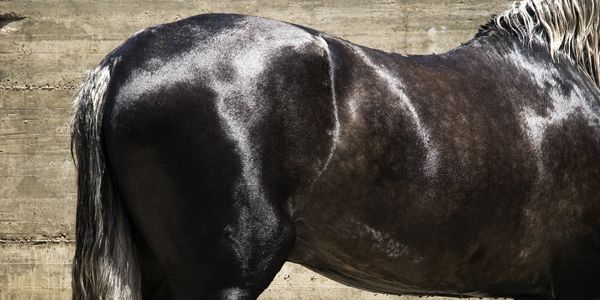Feeding Horses For Dapples- 5 Tips
A gleaming coat reflects fine health and well-being among horses and ponies. Grooming intensity and frequency as well as nutritional status are two obvious explanations for a top-notch hair coat. In addition to those factors, nutritional supplements that target shiny, healthy coats are among the most popular dietary products in the United States.*
“This is not really surprising considering that a robust, shiny coat is widely considered a sign of health and vitality. In addition to supporting bloom, nutrition can also impact finer features of a horse’s coat, such as dapples,” shares Kathleen Crandell, Ph.D., a Kentucky Equine Research nutritionist.
Dapples are round areas of hair that appear more deeply or differently colored than the base or surrounding coat. Dappling is relatively common in gray horses and less frequently seen in other colors, such as bays and chestnuts. Coat color, including the presence of dapples, is genetically controlled, but nongenetic factors, including regular grooming and provision of a well-balanced diet, can improve a horse’s coat and dappling.
How can you feed your horse to make his dapples stand out? Here are five tips:
1. Ensure your horse is receiving a sufficient amount and appropriate quality of forage, whether it is pasture or hay. Though alfalfa (lucerne) and other legume forages are not appropriate for all horses, some horsemen and horsewomen believe that the rich protein content of these forages helps add bloom to a horse’s coat.
2. Manage insects to minimize allergic reactions, hives, and insect bite hypersensitivity. Omega-3 fatty acids are thought to help with both of these conditions. Certain omega-3 supplements, such as EO•3, are known to help with problems associated with insect hypersensitivity.
3. Provide calories in the form of fat. High-fat ingredients such as vegetable oil and stabilized rice bran are ingredients in many quality feeds. One side effect of feeding fat is a boost in coat quality. Care should be applied in deciding which horses are best suited for a fat-rich feed or a fat supplement. Do not allow your horse to become obese. Appropriate, healthy body condition is mirrored in coat quality and will help keep metabolic issues at bay.
4. Blanket during rain to avoid rain rot, and routinely treat horses for both internal and external parasites including pinworms and mange. Regular deworming ensures horses receive maximal nutrition from their meals. Many veterinarians recommend microscopic fecal examination so deworming schedules can be tailored to individual horses.
5. Feed a well-balanced diet with the appropriate levels of protein, minerals, and vitamins to ensure the coat has the proper nutrients for healthy hair growth, as well as maintaining the overall health of the horse. Consider forage analysis to ensure nutrient excesses or deficiencies are not present or to rapidly correct them when necessary.
“If you do choose to supplement with oils, balancers, concentrates, herbs, or other dietary products consider consulting with your veterinarian or equine nutritionist to identify the most appropriate product, taking into consideration all of your horse’s dietary and health concerns,” advises Crandell.
*Packaged Facts. Pet Supplements and Nutritional Treats in the U.S., 5th edition. February 2015.
Horse coat quality is dependent on balanced nutrition, and Bio•Bloom™ PS includes the essential amino acids and fatty acids important for optimal coat condition. Bio•Bloom PS is a dual-action horse supplement designed to promote and maintain healthy hooves and skin from the inside out.
Seasonal Spotlight reprinted courtesy of Kentucky Equine Research. Read more and subscribe at equinews.com.











